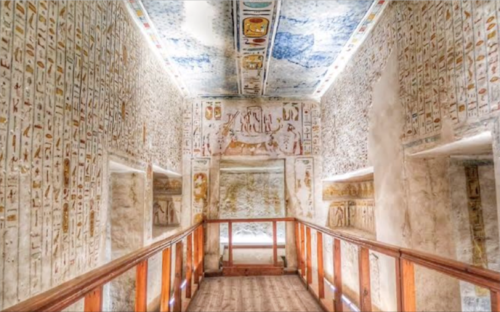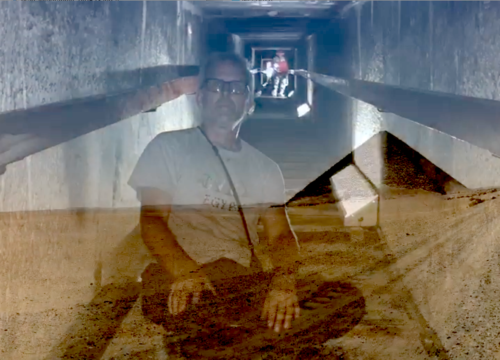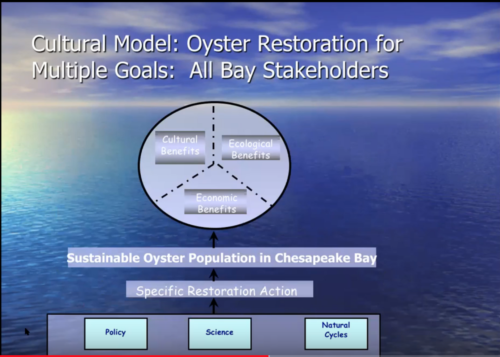How a cultural model can help with your travel plans
Brian Scott ·By: Brian Scott
When Herodotus, the world's first historian, visited Egypt in the fifth century BC,
he asked its priests what was the key to Egypt's greatness.
"Egypt is the gift of the Nile", they said.1
This summer I vacationed in Egypt. I have seen few things as jaw-dropping and awe-inspiring as the Valley of the Kings. Put it on your bucket list.

Before you go, be sure you adopt a Cultural Model of the Egyptian tourism industry. A cultural model describes the implicit, collective knowledge and understanding about how to behave. I'm sure many of the Egyptians I encountered were behaving in a perfectly normal way. However, I felt like it was the zombie apocalypse, only instead of coming to kill me, they wanted to sell me some trinket or ask for "tips". A cultural model would have helped me communicate better and understand where these people were coming from. One man was endlessly badgering me until I dashed across a busy street, through traffic, to get away. He shouted after me, "Just tell me what you want!" Frazzled by the constant assaults I shouted back, "Solitude!"
Ironically, the next day I spent 15 minutes, alone, in the burial chamber of the Dahshur pyramid. It was an incomparable cathartic solitude experience. My would-be harasser didn't contribute directly to my pyramid venture, but he is, as much as anyone, an integral part of Egypt's cultural heritage.

I also visited the Aswan dam on the Nile river. In 1970, Egypt completed this controversial structure. For thousands of years, Egypt was the most powerful and affluent country in the world in part because the (un-dammed) Nile would flood every year, depositing nutrient-rich topsoil. In an otherwise parched and barren desert, crops were plentiful and reliable. Now, without flood sediment, farmers depend on chemical fertilizers. On the other hand, they can grow up to four crops per year, instead of one. The dam also supplies most of Egypt's power needs. There is a long list of pros and cons that were weighed, and Egypt eventually came to a "Cultural Consensus" that the dam was the correct choice for their contemporary culture.
The term Cultural Consensus is an analytical model used by some anthropologists, including the University of Maryland's Dr. Michael Paolisso. This tool operationalizes culture by quantifying and weighing factors that contribute to a prevailing cultural mindset. Even though I don't understand Egyptian culture, or what contributes to their distributed knowledge, it was still obvious to me they had reached consensus- they like their dam, or at the very least, they like the benefits it imparts. A cultural consensus analysis likely could identify why.
Closer to home, Dr. Paolisso has studied Cultural Models and applied a Cultural Consensus Analysis to issues facing the Chesapeake Bay. Like the Nile River, the Bay has a life of its own, and gives rise to a sense of Bay culture. Two key elements of this culture are harvesting blue crabs and oysters.

The Chesapeake Bay is normally home to hundreds of millions of blue crabs. Starting in 1999, there were several years of seriously depleted populations, and resource managers concluded that the solution was to reduce commercial harvesting. Watermen disagreed- regulations wouldn't work. Dr. Paolisso recognized that watermen must have some implicit knowledge operating underneath their assertion and studied cultural models to further investigate.2
First and foremost, watermen recognize that there are many factors that determine crab populations, and most of them are beyond our understanding or control. For most watermen, God controls nature, including crabs. Beyond this recognition of the complexity and unpredictability of nature, watermen believe it is human pressures, particularly pollution, that adversely impact crabs. Watermen point out that any policy or scientific inquiry should first address Bay pollution.

In 2006, a large research effort began to evaluate whether or not to introduce a non-native oyster species into the Bay in order to increase oyster harvests.3 Dr. Paolisso was among a team of scientists of varying disciplines that evaluated the problem.
Dr. Paolisso applied used Cultural Consensus Model analyses to determine whether stakeholders had common beliefs and goals. And they did. Virtually everyone agreed that any restoration effort should result in equal measures of cultural, economic and ecological benefit.4 Another discovery of the study was that watermen favored the introduction of non-native species whereas environmentalists and scientists did not.

Dr. Paolisso laments that when it came to a final policy decision, his and other scientific input seemed nothing more than pomp. I don't see it that way. According to a report at Yale University, somehow the message got though. After being decimated by disease, pollution, and overharvesting, the Chesapeake Bay's renowned oysters are thriving once again, thanks largely to a selectively bred oyster that grows rapidly and is more resistant to pathogens. Perhaps the studies of cultural models and cultural consensus, themselves, ultimately helped to shape and modify the cultural model of the Bay. It just took a little time.
References
1. Brier, Bob, and A. Hoyt Hobbs. 2013. Ancient Egypt : Everyday Life in the Land of the Nile. New York: Sterling.
2. Paolisso, Michael. "Blue crabs and controversy on the Chesapeake Bay: A cultural model for understanding watermen's reasoning about blue crab management." Human Organization (2002): 226-239.
3. Ruth, Matthias, ed. Handbook of research methods and applications in environmental studies. Edward Elgar Publishing, 2015.
4. Paolisso, Michael, and Nicole Dery. "A cultural model assessment of oyster restoration alternatives for the Chesapeake Bay." Human Organization (2010): 169-179.
Next Post > The 21st International Riversymposium
Comments
-
Alexandra Fries 5 years ago
I'm not sure how oyster populations in the Bay are thriving as they are at less than 1% of their historic levels. Perhaps you meant to say that oyster farming and aquaculture are thriving in the bay?
-
Emily Nastase 5 years ago
Very cool post! I love how you connected cultural models to a completely different scenario. I also appreciate the optimistic suggestion at the end that the process of creating a cultural model in the Chesapeake wasn't all for nothing. And I agree—at the very least I think it was necessary to have these different groups of stakeholders together in an active discussion.
-
Natalie 5 years ago
Fantastic blog post...loved the reference to a very personal experience and how you looked at the Egyptians from a cultural consensus perspective and the pictures are great! You captured my interest from the beginning.
-
Alexander Sahi 5 years ago
I am not sure that you can just "adopt" a cultural model, and this phrasing might be a bit problematic as anthropologists seek to understand cultural models and not necessarily adopt them. It sounds like at the beginning of this what is needed is more cultural relativism than cultural models. From my understanding, a cultural model is comprised of the implicit beliefs shared by a group of people about their own culture, and this is what is gathered through qualitative analysis by social scientists.
-
Morgan Ross 5 years ago
Brian, I thought this post was very entertaining. While I enjoyed reading it, I am not sure that it adequately described the cultural models we discussed in class.
Our in-class conversation was very interesting because we got to see the cultural models put to practice and understand how it helped (or rather, didn't help) inform policy. One of the most shocking things Dr. Paolisso brought up was that he didn't think that the cultural model results made any significant impact on the outcome of the project. Even though the results of the analysis were reputable, the decision makers had already made up their minds about the outcome. -
Brendan Campbell 5 years ago
I thought your relation to a cultural consensus to the case in Egypt was interesting. I wonder if the model was tested for the different stakeholders around the Nile would have a significant consensus. Switching to oysters, I agree that having social sciences implemented in these decisions are important. Whether the outcome was pre-decided or not, the project still involved watermen and their perspectives which very well could have influenced them to be more open-minded with scientific data and conclusions for future work. Interaction is vital to putting all classes of stakeholders on the same team which is the motivation behind the consensus model in the first place.
-
Alana Todd-Rodriguez 5 years ago
It was interesting to read about your trip to Egypt. I see cultural modeling and consensus as more of a tool set to measure shared understandings. Groups can't just "come to" those, at least explicitly without properly using the methodology. Just because they all can agree on something doesn't mean they have arrived at a consensus, at least not in the context taught in class. You took a dynamic approach to the concepts and it was fun to read.
-
Srishti Vishwakarma 5 years ago
A great way of connecting the concept of cultural consensus model with your amazing trip to Egypt. It is interesting to see that the model is not only applicable in the Bay Area but also we can think about its application in other areas of the world. It could be very beneficial to engage as many surveys as we can to improve the efficiency of the model. Conducting surveys could benefit all the three domains, which are cultural, economic and ecological, as mentioned in on of your picture in the blog. I really liked your blog and its connection to the Egypt!
-
Shannon 5 years ago
I like how you made the personal connection to your experience in Egypt after the fact. Understanding others' culture is often difficult in the moment but I loved your reflection on the experiences. I can understand Dr. Paolisso's perception of the lack of weight given to scientific input; this same sentiment has been shared by others involved in this process. The questions asked as a component of the Oyster PEIS Cultural Consensus Model were fascinating and I would be intrigued to see how stakeholders would respond to the same questions today.
-
Tan Zou 5 years ago
Thank you, Brian, for sharing your exciting trip to Egypt! I think cultural approaches are very useful tools for us to understand what farmers believe and figure out ways to cooperate with them, and with any other stakeholders. However, we also need to be aware of possible survey sampling bias when conducting similar studies.